 Database
Database
 Mysql Tutorial
Mysql Tutorial
 Finally understand that MySQL index needs to use B+tree, and it's so fast
Finally understand that MySQL index needs to use B+tree, and it's so fast
Finally understand that MySQL index needs to use B+tree, and it's so fast
mysql tutorial column introduces the B tree of understanding the index.
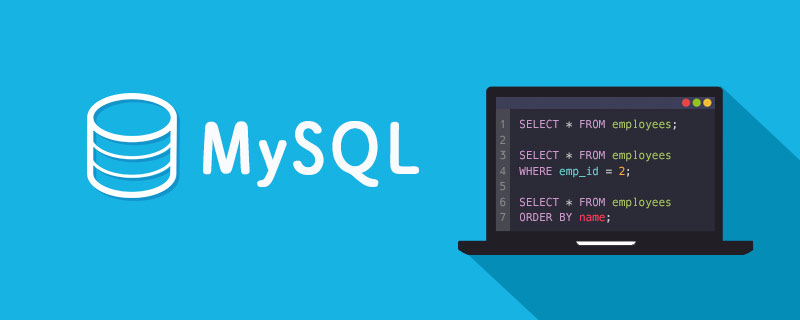
Free recommendation: mysql tutorial(Video)
Preface
When you encounter a slow SQL and need to optimize it, what optimization method can you think of immediately?
Most people’s first reaction may be Add index. In most cases, index can add a query to a SQL statement. The efficiency is improved by several orders of magnitude.
Essence of index: A data structure used to quickly find records.
Commonly used indexesData structure:
- Binary tree
- Red-black tree
- Hash table
-
B-tree(B tree is not called B minus tree) B tree
Data structure GraphicalWebsite: https://www.cs.usfca.edu/~galles/visualization/Algorithms.html
Index query
Everyone knowsselect * from t where col = 88 If such a SQL statement is searched without using the index, the normal search is full table scan: search row by row starting from the first row of the table , comparing the value of the col field in each row with 88, this is obviously very inefficient.
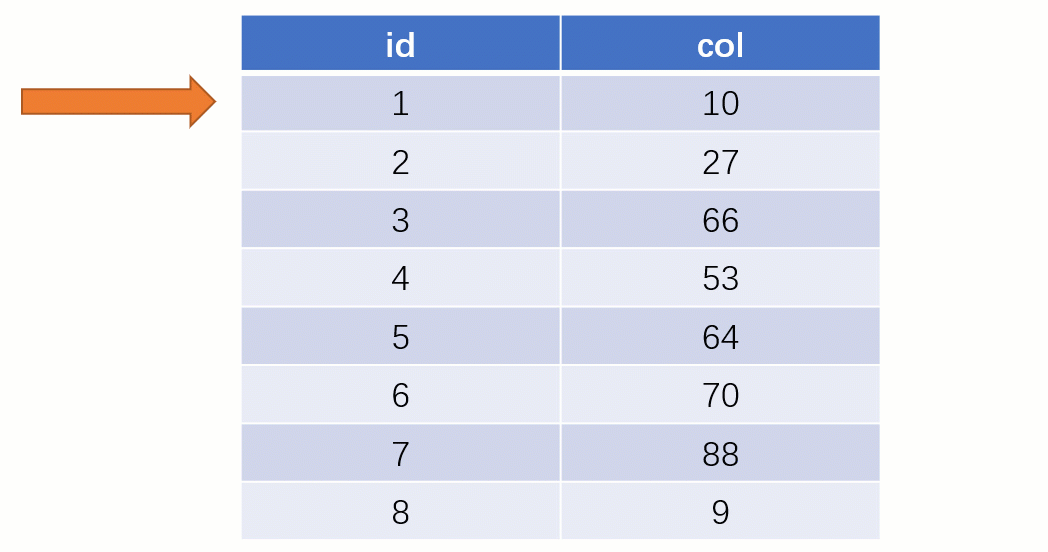
And if you use an index, the query process is completely different (assuming that a balanced binary tree data structure is used to store our index columns )
The storage structure of the binary tree at this time (Key - Value): Key is the data of the index field, and Value is the disk file address of the row where the index is located.
When 88 is finally found, you can take out the disk file address corresponding to its Value, and then go directly to the disk to find this line of data. The speed at this time It will be much faster than a full table scan.
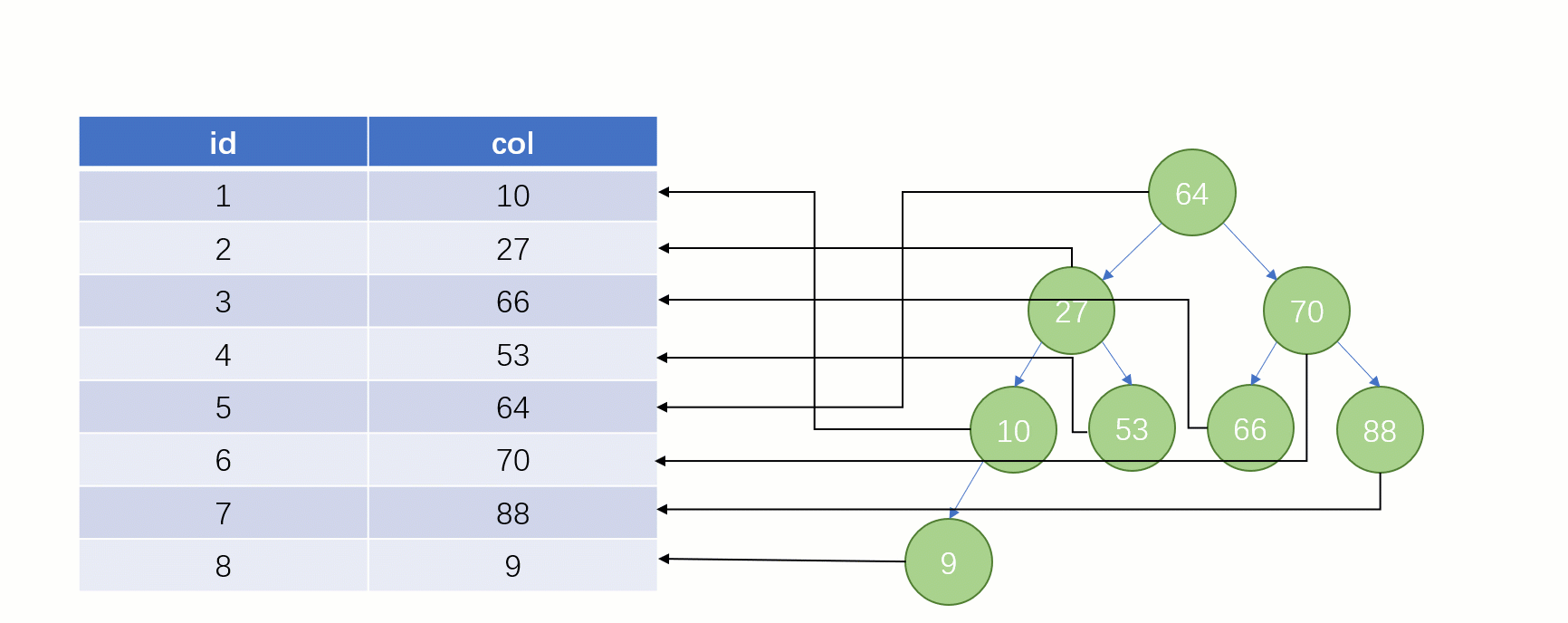
Butactually MySQL The bottom layer does not use binary tree to store index data, it uses B tree (B tree) .
Why not use a binary tree
Assuming that an ordinary binary tree is used to record the id index column, we must maintain the binary tree index field while inserting a row of records.
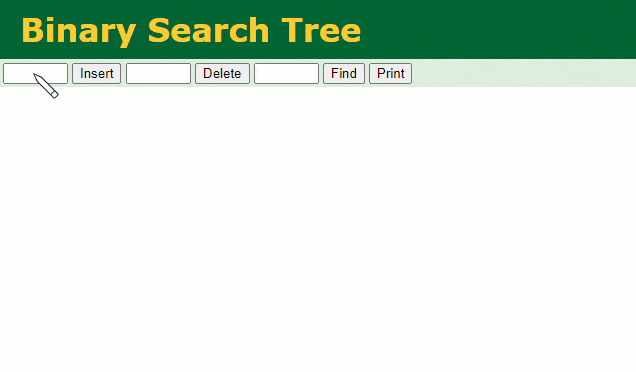
At this time, when I want to find the data with id = 7, the search process is as follows:

At this time, we searched for the row id = 7 7 times, which is not much different from our full table scan. Obviously, the binary tree is actually a data structure that is not suitable as an index for this increasing data column.
Why not use Hash table
Hash table: a data structure for fast search, the time complexity of search is O(1)
Hash function: convert a Any type of key can be converted into an int type subscript
Assuming that the Hash table is used to record the id index column, we insert a row of records at the same time Maintain Hash table index fields.

At this time, the tree node with id = 7 was searched only 1 times, which is very efficient.

But the index of MySQL stilldoes not use the Hash table that can be accurately positioned. Because it does not apply to range queries .
The red-black tree is a specialized AVL tree (balanced binary tree), which is maintained through specific operations during insertion and deletion operations. Balance of binary search trees; If a binary search tree is a red-black tree, then any of its subtrees must be a red-black tree.
Assuming that the red-black tree record id index column is used at this time, we must maintain the red-black tree index field while inserting a row of records.

During the insertion process, you will find that it is different from ordinary binary trees in that when the height difference between the left and right subtrees of a tree is > 1, it will spin Operation to keep the tree balanced.
At this time, the tree node with id = 7 was searched only 3 times, which is faster than the so-called ordinary binary tree.
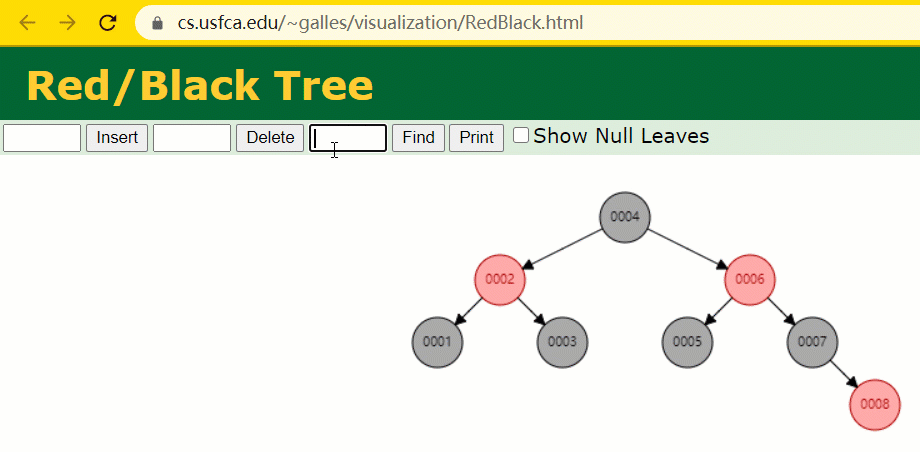
But MySQL’s index stilldoes not use which is excellent in precise positioning and range queryred-black tree.
Because when MySQL the amount of data is large, the size of the index will also be very large, and the memory may not be able to store it, so related reading and writing need to be done from the disk. If the tree level is too large If it is high, the number of disk reads and writes (I/O interactions) will be greater, and the performance will be worse.
B-tree
The only shortcoming of the red-black tree is that the height of the tree is uncontrollable, so now our entry point is the tree the height of.
Currently, a node is only allocated to store 1 element. If we want to control the height, we can allocate a larger space to a node and let it store multiple elements horizontally , at this time the height is controllable. Through such a transformation process, it became
B-tree.

B-tree is an absolutely balanced multi-way tree. There are two concepts in its structure: Degree: the number of child nodes (subtrees) that a node has. (Some places use
to explainis a balanced m-way search tree. It may be an empty tree, or it may meet the following characteristics:B-tree, explain it here)
)Order: the maximum number of child nodes of a node . (Usually represented bymKeyword: data index.
An m-order
B-tree
##⌈
-
⌈#⌈
All leaf nodes are located on the same layer. - The meaning of the name (off topic, relax)
The following is excerpted from Wikipedia
B-tree
in 1972 while working at Boeing Research Labs, but they did not explain that B stood for What meaning (if any).Douglas Comer explains: Neither author ever explained the original meaning of B-tree
. We might feel that balanced, broad or bushy might be appropriate. Others suggested the letter B stood for Boeing. Due to his sponsorship, however, it seems more appropriate to think ofB-tree as a Bayer tree.
B-tree in his paper titled "CS144C classroom lecture about disk storage and B-trees" published in May 1980 Name interpretation, suggesting that B may mean Boeing or Bayer's name. Search
The search for B-tree is actually very similar to a binary tree:
B-tree
has k keywords and (k 1) branches.The search in the binary tree only considers whether to go left or right, while B-tree
B-tree
- First find the node. Since
B-treeis usually stored on the disk, this step requires disk IO operation; - Find the key word, when a node is found, the node is read into the memory and then the keyword is found through sequential or binary search. If the keyword is not found, you need to judge the size to find a suitable branch to continue searching.
Operation process
Now you need to find the element: 88
First time: Disk IO

The second time: Disk IO

The third time: Disk IO
Then there is a memory comparison, which is compared with 70 and 88 respectively, and finally 88 found.

From the search process, we found that B-tree The number of comparisons and the number of disk IOs are actually not much different from those of binary trees. It seems that there is no difference. What advantages.
But if you take a closer look, you will find that the comparison is completed in memory, does not involve disk IO, and the time consumption is negligible.
In addition, B-tree can store many keywords (the number is determined by the order) in one node, and the same number of keywordsThe nodes generated in B-tree are far less than the nodes in the binary tree, and the difference in the number of nodes is equivalent to the number of disk IOs. After reaching a certain number, the performance difference becomes apparent.
Insertion
When B-tree wants to insert a keyword, it directly finds the leaf node and performs the operation.
- Find the leaf node to be inserted according to the keyword to be inserted;
- Because the maximum number (order) of child nodes of a node is m , so it is necessary to determine whether the number of keywords in the current node is less than (m - 1).
- Yes: Insert directly
- No: Node split occurs. The node is divided into left and right parts based on the middle keyword of the node, and the middle keyword is placed Just go to the parent node.
Operation process
For example, we now need to insert elements in the B-tree with Max Degree (order) of 3: 72
-
Find the leaf node to be inserted

Node split: It should be with [70,88] On the same disk block, but when a node has 3 keywords, it may have 4 child nodes, which exceeds the maximum degree 3 of the limit we defined, so split## must be performed at this time #: Divide the node into two using the middle keyword as the boundary, generate a new node, and move the middle keyword up to the parent node.

Tip: When there are two middle keywords, the left keyword is usually used Move up the split.
DeleteThe deletion operation will be more troublesome than search and insertion, because the keyword to be deleted may or may not be on the leaf node, and deletion may also causeB-tree is unbalanced, and operations such as merging and rotation are required to maintain the balance of the entire tree.
The above is the detailed content of Finally understand that MySQL index needs to use B+tree, and it's so fast. For more information, please follow other related articles on the PHP Chinese website!

Hot AI Tools

Undresser.AI Undress
AI-powered app for creating realistic nude photos

AI Clothes Remover
Online AI tool for removing clothes from photos.

Undress AI Tool
Undress images for free

Clothoff.io
AI clothes remover

AI Hentai Generator
Generate AI Hentai for free.

Hot Article

Hot Tools

Notepad++7.3.1
Easy-to-use and free code editor

SublimeText3 Chinese version
Chinese version, very easy to use

Zend Studio 13.0.1
Powerful PHP integrated development environment

Dreamweaver CS6
Visual web development tools

SublimeText3 Mac version
God-level code editing software (SublimeText3)

Hot Topics
 1382
1382
 52
52
 MySQL: Simple Concepts for Easy Learning
Apr 10, 2025 am 09:29 AM
MySQL: Simple Concepts for Easy Learning
Apr 10, 2025 am 09:29 AM
MySQL is an open source relational database management system. 1) Create database and tables: Use the CREATEDATABASE and CREATETABLE commands. 2) Basic operations: INSERT, UPDATE, DELETE and SELECT. 3) Advanced operations: JOIN, subquery and transaction processing. 4) Debugging skills: Check syntax, data type and permissions. 5) Optimization suggestions: Use indexes, avoid SELECT* and use transactions.
 How to open phpmyadmin
Apr 10, 2025 pm 10:51 PM
How to open phpmyadmin
Apr 10, 2025 pm 10:51 PM
You can open phpMyAdmin through the following steps: 1. Log in to the website control panel; 2. Find and click the phpMyAdmin icon; 3. Enter MySQL credentials; 4. Click "Login".
 MySQL: An Introduction to the World's Most Popular Database
Apr 12, 2025 am 12:18 AM
MySQL: An Introduction to the World's Most Popular Database
Apr 12, 2025 am 12:18 AM
MySQL is an open source relational database management system, mainly used to store and retrieve data quickly and reliably. Its working principle includes client requests, query resolution, execution of queries and return results. Examples of usage include creating tables, inserting and querying data, and advanced features such as JOIN operations. Common errors involve SQL syntax, data types, and permissions, and optimization suggestions include the use of indexes, optimized queries, and partitioning of tables.
 Why Use MySQL? Benefits and Advantages
Apr 12, 2025 am 12:17 AM
Why Use MySQL? Benefits and Advantages
Apr 12, 2025 am 12:17 AM
MySQL is chosen for its performance, reliability, ease of use, and community support. 1.MySQL provides efficient data storage and retrieval functions, supporting multiple data types and advanced query operations. 2. Adopt client-server architecture and multiple storage engines to support transaction and query optimization. 3. Easy to use, supports a variety of operating systems and programming languages. 4. Have strong community support and provide rich resources and solutions.
 How to use single threaded redis
Apr 10, 2025 pm 07:12 PM
How to use single threaded redis
Apr 10, 2025 pm 07:12 PM
Redis uses a single threaded architecture to provide high performance, simplicity, and consistency. It utilizes I/O multiplexing, event loops, non-blocking I/O, and shared memory to improve concurrency, but with limitations of concurrency limitations, single point of failure, and unsuitable for write-intensive workloads.
 MySQL and SQL: Essential Skills for Developers
Apr 10, 2025 am 09:30 AM
MySQL and SQL: Essential Skills for Developers
Apr 10, 2025 am 09:30 AM
MySQL and SQL are essential skills for developers. 1.MySQL is an open source relational database management system, and SQL is the standard language used to manage and operate databases. 2.MySQL supports multiple storage engines through efficient data storage and retrieval functions, and SQL completes complex data operations through simple statements. 3. Examples of usage include basic queries and advanced queries, such as filtering and sorting by condition. 4. Common errors include syntax errors and performance issues, which can be optimized by checking SQL statements and using EXPLAIN commands. 5. Performance optimization techniques include using indexes, avoiding full table scanning, optimizing JOIN operations and improving code readability.
 MySQL's Place: Databases and Programming
Apr 13, 2025 am 12:18 AM
MySQL's Place: Databases and Programming
Apr 13, 2025 am 12:18 AM
MySQL's position in databases and programming is very important. It is an open source relational database management system that is widely used in various application scenarios. 1) MySQL provides efficient data storage, organization and retrieval functions, supporting Web, mobile and enterprise-level systems. 2) It uses a client-server architecture, supports multiple storage engines and index optimization. 3) Basic usages include creating tables and inserting data, and advanced usages involve multi-table JOINs and complex queries. 4) Frequently asked questions such as SQL syntax errors and performance issues can be debugged through the EXPLAIN command and slow query log. 5) Performance optimization methods include rational use of indexes, optimized query and use of caches. Best practices include using transactions and PreparedStatemen
 How to recover data after SQL deletes rows
Apr 09, 2025 pm 12:21 PM
How to recover data after SQL deletes rows
Apr 09, 2025 pm 12:21 PM
Recovering deleted rows directly from the database is usually impossible unless there is a backup or transaction rollback mechanism. Key point: Transaction rollback: Execute ROLLBACK before the transaction is committed to recover data. Backup: Regular backup of the database can be used to quickly restore data. Database snapshot: You can create a read-only copy of the database and restore the data after the data is deleted accidentally. Use DELETE statement with caution: Check the conditions carefully to avoid accidentally deleting data. Use the WHERE clause: explicitly specify the data to be deleted. Use the test environment: Test before performing a DELETE operation.




